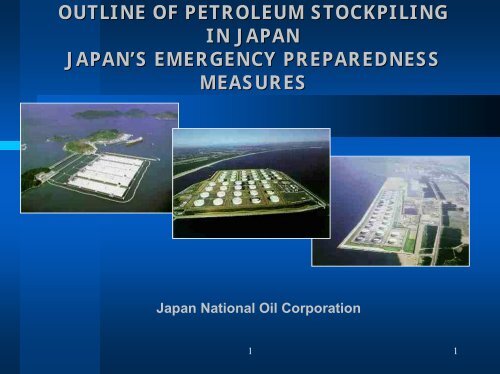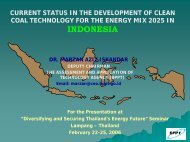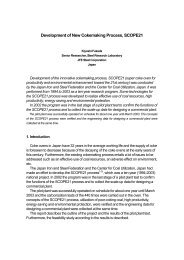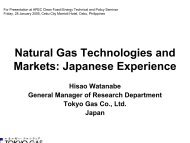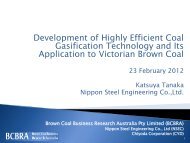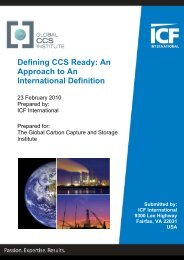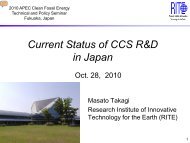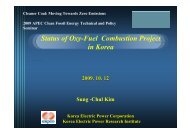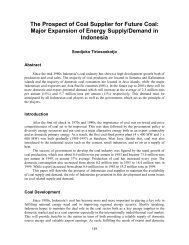OUTLINE OF PETROLEUM STOCKPILING IN JAPAN JAPAN'S ...
OUTLINE OF PETROLEUM STOCKPILING IN JAPAN JAPAN'S ...
OUTLINE OF PETROLEUM STOCKPILING IN JAPAN JAPAN'S ...
You also want an ePaper? Increase the reach of your titles
YUMPU automatically turns print PDFs into web optimized ePapers that Google loves.
<strong>OUTL<strong>IN</strong>E</strong> <strong>OF</strong> <strong>PETROLEUM</strong> <strong>STOCKPIL<strong>IN</strong>G</strong><br />
<strong>IN</strong> <strong>JAPAN</strong><br />
<strong>JAPAN</strong>’S S EMERGENCY PREPAREDNESS<br />
MEASURES<br />
Japan National Oil Corporation<br />
1 1
Contents<br />
1 JNOC Organization and general affairs<br />
2 History of JNOC<br />
3 Outline of petroleum stockpiling system in Japan<br />
4 Distribution map of national reserve oil<br />
5 The current state of Japan’s national and private reserves<br />
6 Emergency Response Measures<br />
7 Pre-emergency Actions regulated by CERM manual<br />
-2-
1. JNOC Organization and general affairs<br />
1. Stockpiling of petroleum<br />
2. Loans for the purchase of petroleum for strengthening stockpiles<br />
3. Loans and or funds for the establishment of institutions that enhance petroleum<br />
stockpiling<br />
4. Funds for exploration of offshore oil resources in Japan and overseas<br />
5. Loans for exploration and production of offshore oil resources in Japan and overseas<br />
6. Guarantee debts relating to the cost of exploration and production of oil overseas<br />
7. Lend equipment and machinery necessary for the exploration of oil<br />
8. Technical assistance and guidance relating to exploration and production of oil<br />
9. Geological surveys necessary for the exploration and production of petroleum<br />
10. Obtain legal rights to explore and exploit petroleum sources overseas<br />
11. Research and development of exploration techniques<br />
12. Gather of information relating to the production of oil and stockpiling methods<br />
-3-
2. History of the JNOC<br />
Oct. 1967<br />
May. 1972<br />
Mar. 1975<br />
Jun. 1975<br />
Dec. 1975<br />
Apr. 1976<br />
Jun. 1978<br />
Mar. 1981<br />
Establishment of the Japan National Oil Development Corporation<br />
Revision of the JNODC law<br />
•Loans for the purchase of crude oil for stockpiling (advancement of private<br />
reserve)<br />
Reached the target of 60 days private reserve<br />
Revision of the JNODC law<br />
•Start up of equity capital • or joint oil storage companies.<br />
Petroleum Stockpiling Law Issued<br />
•Mandatory reserve obligations placed on Petrol refineries and related enterprises<br />
Enactment of Petroleum Stockpiling Law<br />
•Equity capital for Joint oil stockpiling companies.<br />
Revision of the JNODC law<br />
•Start up of the national oil reserve venture<br />
•Change of the official name to Japan National Oil Corporation<br />
Reached the target of 90 days private reserve<br />
First completion of National oil storage base•<br />
••Mutsu-ogawara.<br />
-4-
2. History of the JNOC<br />
Nov. 1987<br />
Feb. 1989<br />
Aug. 1996<br />
Feb. 1998<br />
Aug. 1999<br />
Dec. 1999<br />
Commencement of Emergency Release Exercise<br />
• 100,000kl of crude oil loaded from an onshore facility onto a waiting tanker ••<br />
• and then unloaded back onshore<br />
Reached the National reserve target of 30 million kl<br />
Completion of whole (10) national oil storage bases<br />
Reached the National reserve target of 50 million kl<br />
Establishment of New Guideline on Emergency Response<br />
by METI’s Council<br />
Establishment of New Drawdown Manual and CERM system<br />
in response to an pre-emergency by METI and JNOC<br />
-5-
3. Outline of petroleum stockpiling system<br />
Petroleum<br />
Stockpiling<br />
National<br />
Stockpiling<br />
Target of<br />
50 million kl<br />
reached in Feb. 1998<br />
Stockpiling at national<br />
oil storage bases<br />
Private sector tanks<br />
leased by JNOC<br />
Joint<br />
reserves<br />
Public oil<br />
refineries<br />
Private Sector<br />
Stockpiling<br />
Obligatory inventory<br />
70-day consumption<br />
Stockpiling by private<br />
oil companies<br />
-6-
4. Distribution map of national reserve oil<br />
Total amount of national stockpiling bases : 34,134,000kl<br />
Total amount of leased private tanks :<br />
Okinawa Oil Base(OCC)<br />
34 tanks, 3,563,000kl<br />
Okinawa terminal(OTC)<br />
8 tanks, 746,000kl<br />
South-west oil terminal<br />
3 tanks, 298,000kl<br />
Idemitsu Tokuyama<br />
3 tanks, 194,000kl<br />
Seibu Yamaguchi<br />
10 tanks, 1,218,000kl<br />
Shirashima<br />
8 tankers, 4,752,000kl<br />
Kamigoto, 5tankers<br />
3,408,000kl<br />
Kushikino, 3 tanks<br />
1,684,000kl<br />
Nisseki Kiire<br />
15 tanks, 2,125,000kl<br />
Shibushi, 40 tanks<br />
4,276,000kl<br />
15,754,000kl<br />
Nippon Mitsubishi<br />
Mizushima<br />
1 tank, 101,000kl<br />
Kikuma, 8 tanks<br />
1,417,000kl<br />
Akita, 15 tanks,<br />
3,730,000kl<br />
Niigata joint reserve<br />
10 tanks, 861,000kl<br />
Showa Shell Niigata<br />
3 tanks, 294,000kl<br />
Koa Osaka<br />
1 tank, 68,000kl<br />
Fukui, 27 tanks,<br />
2,855,000kl<br />
Wakayama Osaki<br />
1 tank, 83,000kl<br />
Tonen Wakayama<br />
1 tank, 88,000kl<br />
Based on stored reserve volume,Jul. 31,2001<br />
Idemitsu Aichi<br />
7 tanks, 631,000kl<br />
Hokkaido joint reserve<br />
27 tanks, 2,956,000kl<br />
Tomakomai-Tobu<br />
55 tanks, 5,425,000kl<br />
Mutsu-Ogawara<br />
53 tanks, 4,923,000••<br />
Kuji<br />
l<br />
3 tanks, 1,665,000kl<br />
Onahama<br />
6 tanks, 498,000kl<br />
Kashima tank yard<br />
8 tanks, 996,000kl<br />
Idemitsu Chiba<br />
6 tanks, 451,000kl<br />
Kyokuto Chiba<br />
2 tanks, 69,000kl<br />
Fuji Sekiyu Sodegaura<br />
8 tanks, 514,000kl<br />
-7-
5. The current state of Japan‘s s national and private<br />
reserves<br />
Million kl<br />
120<br />
100<br />
80<br />
60<br />
40<br />
20<br />
0<br />
Government stockpiling<br />
Private sector stockpiling<br />
7<br />
7<br />
17 20 24 31 35 42 45 51 53 54 56 61 67 74 75 76 81 85 85 84<br />
57 61 77 79 93 94 85 92 98 101 99 98 96 90 97 98 91 90 88 86 82 80 84 74 80 86 82 76 77<br />
72 73 74 75 76 77 78 79 80 81 82 83 84 85 86 87 88 89 90 91 92 93 94 95 96 97 98 99 00<br />
Major<br />
events<br />
•First oil crisis •Second oil shock •Gulf war<br />
•Inauguration of IEA<br />
•Introduction of oil reserve law<br />
•Enactment of oil reserve law<br />
Government<br />
stockpiling<br />
30 millions kl policy(78) 50 millions kl policy(89)<br />
Private sector<br />
stockpiling<br />
Set-up to 60 day reserve policy plan(72)<br />
Set-up to 90 day reserve policy plan(75)<br />
Set-up to 70 day reserve policy plan(89)<br />
Notes 1 ; Reserve amounts are based on a conversion from private and national reserve products<br />
Notes 2 ; Reserve days figures are based on the Petroleum Reserve Law<br />
-8-
5. The current state of Japan‘s s national and private<br />
reserves<br />
Authorized by<br />
Current reserve days<br />
(As of end of June.2001)<br />
Current reserve volume<br />
(As of end of June.2001)<br />
Holding make-up<br />
(As of end of June.2001)<br />
Existing reserve goal<br />
Storage place<br />
Holding format<br />
Maintenance etc.<br />
national stockpiling<br />
The JNOC Law<br />
86days<br />
47,400,000kl (Product base)<br />
49,895,000kl (crude oil base)<br />
100% Crude oil<br />
50 million kl (achieved Feb. 1998)<br />
National stockpile base, private<br />
tanks<br />
The “Sealed method”<br />
After the oil has been separated by<br />
type, the tank is sealed, and managed<br />
as property.<br />
Private sector stockpiling<br />
Petroleum stockpiling Law<br />
80 days<br />
44,067,000kl (product base)<br />
Product oil 52%, Crude oil 48%<br />
70 days of domestic consumption<br />
Refinery, oil tankers, private tanks<br />
Held in the distribution process<br />
Crude, volatile, kerosene, light and<br />
heavy oil are held by type in<br />
accordance to standard holding volume<br />
criteria. But, with the Minister of<br />
METI’s approval, the types of oils<br />
held may be substituted.<br />
-9-
5. The current state of Japan‘s s national and private<br />
reserves<br />
Form of storage<br />
Responsible Party<br />
Financial assistance<br />
measures<br />
Cost burden<br />
Government stockpiling<br />
Held in sealed containers<br />
(Crude oil)<br />
- National reserve companies<br />
(About 2/3 of National reserve total volume)<br />
Financing is 70% JNOC, and 30%<br />
private enterprises and local<br />
governments, 8 companies and 10 bases<br />
- Private downstream companies<br />
(About 1/3 of National reserve total volume)<br />
JNOC leases surplus private sector tanks<br />
and entrusts them with the national<br />
reserve oil.<br />
Government bears the cost<br />
A source of revenue, oil tax<br />
becomes part of product cost<br />
(Ultimately it can be expected to be<br />
passed on to the consumer)<br />
Private sector stockpiling<br />
Held in distribution process<br />
(Crude oil and oil product)<br />
Refiners, importers etc.<br />
However, can be managed by joint<br />
reserve companies. (JNOC has a policy<br />
allowing for investment in joint reserve<br />
companies.)<br />
Oil purchase funds, tank building<br />
costs etc.<br />
Becomes a part of product cost<br />
(Ultimately it can be expected to be<br />
passed on to the consumer)<br />
-10-
6. Emergency Response Measures<br />
! 1987.11 Commencement of Emergency Release Exercise<br />
• Under emergency conditions, to minimize the time it would take to pump<br />
the national reserves into the market• JNOC has been in principle<br />
conducting Emergency Release Exercises with a tanker at 10 national<br />
stockpile bases every other year since 1987.<br />
• During each exercise, 100,000 kl of crude oil is loaded from an onshore<br />
facility onto a waiting tanker and then unloaded back onshore.<br />
-11-
6. Emergency Response Measures<br />
• As of the end of 2000, 51 exercises have been carried out.<br />
Exercise plan in 2001: 4 bases<br />
base period<br />
Akita Aug. 30-Sep. 1<br />
Shirashima Sep. 3-5<br />
Kamigoto in early Oct.<br />
Kuji in late Nov.<br />
Exercise plan in 2002: 6 bases<br />
Tomakomai-Tobu, Mutsu-Ogawara, Kuji, Fukui, Kikuma and Shibushi<br />
-12-
6. Emergency Response Measures<br />
1999.8 Establishment of New Guideline on Emergency Response by<br />
METI’s Petroleum Council<br />
• Whilst the national reserves should still be used as a "last resort" in times<br />
of emergency, this oil should also be drawn down quickly and efficiently to<br />
the market, in anticipation of an announcement, especially when the IEA-CERM<br />
program is invoked in the early stages of pre-emergency.<br />
: More flexible use of the national reserves<br />
• The adequate amount of oil drawdown -- in response to the IEA-CERM program --<br />
should be estimated in consideration of meeting the IEA’s requirement of holding 90<br />
days of net imports, even in the stages of pre-emergency (see page 15).<br />
-13-
6. Emergency Resopnse Measures<br />
1999.12 Establishment of New Drawdown Manual (called ‘‘CERM<br />
Manual’’) and CERM system response to a pre-emergency<br />
by METI and JNOC<br />
•Based on the policy of New Guideline on Emergency Response<br />
established by METI’s Petroleum Council,<br />
METI and JNOC jointly prepared CERM manual for responding to a<br />
pre-emergency in accordance with a policy of full and open disclosure<br />
to the public.<br />
•The CERM manual regulates the amount and procedure of drawdown<br />
to the market in the stages of pre-emergency.<br />
-14-
7. Pre-emergency Actions regulated by CERM manual<br />
1. Amount of drawdown<br />
: Maximum 20 million kl<br />
••<br />
• National oil reserves …• approx. 50 million kl (86 days)<br />
• + Private oil reserves …• approx. 44 million kl (80 days)<br />
94 million kl• 165 days•<br />
• IEA’s way of calculation 118 days<br />
• • IEA’s requirement •• 90 days<br />
•••••••••••••••• •••••••••••28 days• ••22<br />
••••••••••••<br />
•••••••••••••••••••••••••••••••••• 20•<br />
million kl<br />
-15-
7. Pre-emergency Actions regulated by CERM manual<br />
1st Stage<br />
• Drawdown of National Reserves under<br />
the IEA-CERM program (max 20 million kl)<br />
and/or<br />
• Reduction of Private Reserves Obligation<br />
2nd Stage<br />
• Drawdown of Private<br />
Reserves<br />
3rd Stage<br />
• Drawdown of National<br />
Reserves: Last Resort<br />
(min 30 million kl)<br />
-16-
7. Pre-emergency Actions regulated by CERM manual<br />
2. Bases<br />
Considering each base’s necessary time of transitioning from operational<br />
readiness mode to the drawdown operating mode (within 3-4 weeks of the<br />
METI ministerial order to draw down national reserves, see page 21)<br />
and the capable amount of the drawdown etc., 5 national bases and 6 private<br />
sector sites were selected as the bases from which a maximum of 20 million<br />
kl of oil would be drawn down in the early stages of pre-emergency.<br />
5 national bases: Tomakomai-Tobu, Akita, Shirasima, Kamigoto and<br />
Shibushi<br />
6 private sector bases: Hokkaido joint reserve, Niigata joint reserve,<br />
Seibu Yamaguchi, Nisseki Kiore, Okinawa Oil Base (OCC)<br />
and Okinawa terminal (OTC)<br />
-17-
7. Pre-emergency Actions regulated by CERM manual<br />
3.The Sales Process - Use of Market Mechanism<br />
• The principal method for distributing the oil would be by competitive sale to<br />
the highest bidders.<br />
• The sales bidding could be completed within as little as 13 days of the METI<br />
ministerial order to draw down national reserves (see page 21) .<br />
-18-
7. Pre-emergency Actions regulated by CERM manual<br />
4. Drawdown Objectives … • Prevention of Speculation<br />
• Oil companies and oil trading companies regulated by the Petroleum•<br />
Reserve Law are permitted to apply for authorization to take part in<br />
bidding.••<br />
• 13 companies are currently authorized by METI and JNOC as bidders.<br />
-19-
7. Pre-emergency Actions regulated by CERM manual<br />
• The above authorized companies can access the following detailed<br />
information at JNOC’s web-site:<br />
• Oil inventories at 11 bases (amount, characteristics),<br />
• Port and terminal capabilities,<br />
• Terminal throughput capabilities<br />
-20-
7. Pre-emergency Actions regulated by CERM manual<br />
5. Response Time Schedule<br />
• Day 1 METI ministerial decision to draw down national reserves<br />
Day 1-13 Issuance of a ‘‘Notice of Sale’’<br />
Receipt of Bids<br />
Selection of Bidders<br />
Day14-20 Commence awarding contracts<br />
Day21-28 Achieve drawdown readiness at base<br />
Day21- Delivery of oil by tanker<br />
-21-
Sayonara<br />
-22-


